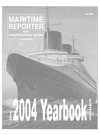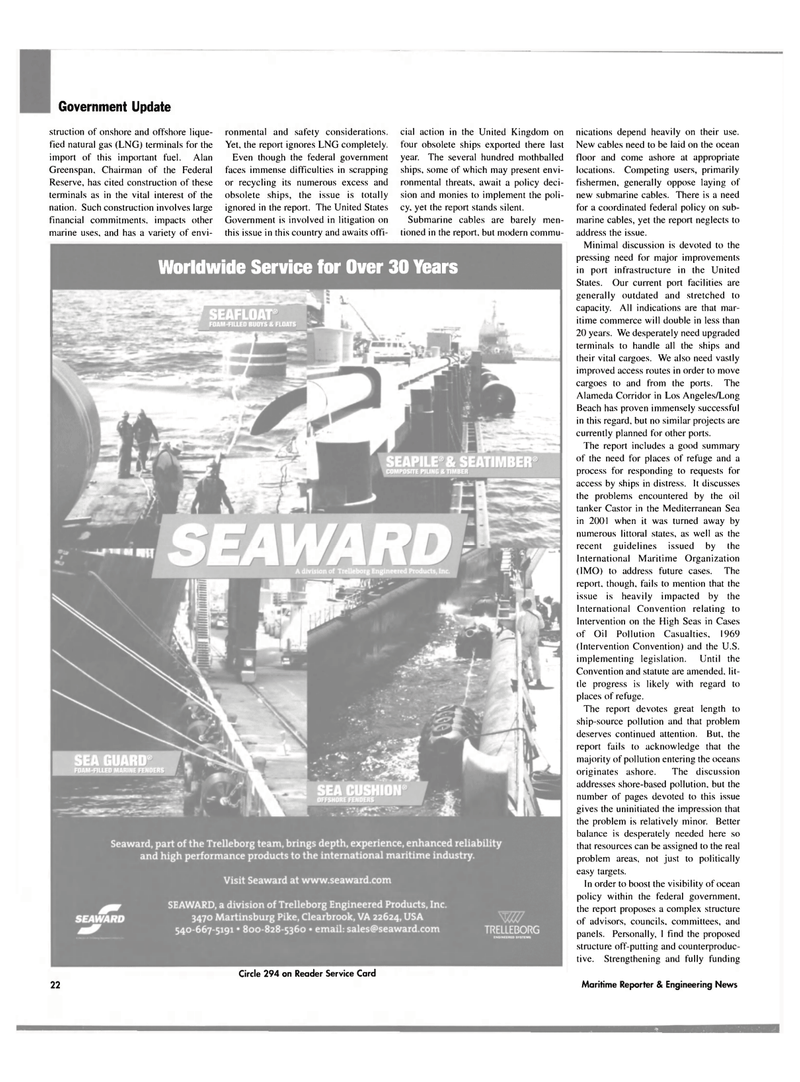
Page 22: of Maritime Reporter Magazine (June 2004)
Annual World Yearbook
Read this page in Pdf, Flash or Html5 edition of June 2004 Maritime Reporter Magazine
Government Update struction of onshore and offshore lique- fied natural gas (LNG) terminals for the import of this important fuel. Alan
Greenspan. Chairman of the Federal
Reserve, has cited construction of these terminals as in the vital interest of the nation. Such construction involves large financial commitments, impacts other marine uses, and has a variety of envi- ronmental and safety considerations.
Yet, the report ignores LNG completely.
Even though the federal government faces immense difficulties in scrapping or recycling its numerous excess and obsolete ships, the issue is totally ignored in the report. The United States
Government is involved in litigation on this issue in this country and awaits offi- cial action in the United Kingdom on four obsolete ships exported there last year. The several hundred mothballed ships, some of which may present envi- ronmental threats, await a policy deci- sion and monies to implement the poli- cy, yet the report stands silent.
Submarine cables are barely men- tioned in the report, but modern commu- nications depend heavily on their use.
New cables need to be laid on the ocean floor and come ashore at appropriate locations. Competing users, primarily fishermen, generally oppose laying of new submarine cables. There is a need for a coordinated federal policy on sub- marine cables, yet the report neglects to address the issue.
Minimal discussion is devoted to the pressing need for major improvements in port infrastructure in the United
States. Our current port facilities are generally outdated and stretched to capacity. All indications are that mar- itime commerce will double in less than 20 years. We desperately need upgraded terminals to handle all the ships and their vital cargoes. We also need vastly improved access routes in order to move cargoes to and from the ports. The
Alameda Corridor in Los Angeles/Long
Beach has proven immensely successful in this regard, but no similar projects are currently planned for other ports.
The report includes a good summary of the need for places of refuge and a process for responding to requests for access by ships in distress. It discusses the problems encountered by the oil tanker Castor in the Mediterranean Sea in 2001 when it was turned away by numerous littoral states, as well as the recent guidelines issued by the
International Maritime Organization (IMO) to address future cases. The report, though, fails to mention that the issue is heavily impacted by the
International Convention relating to
Intervention on the High Seas in Cases of Oil Pollution Casualties, 1969 (Intervention Convention) and the U.S. implementing legislation. Until the
Convention and statute are amended, lit- tle progress is likely with regard to places of refuge.
The report devotes great length to ship-source pollution and that problem deserves continued attention. But, the report fails to acknowledge that the majority of pollution entering the oceans originates ashore. The discussion addresses shore-based pollution, but the number of pages devoted to this issue gives the uninitiated the impression that the problem is relatively minor. Better balance is desperately needed here so that resources can be assigned to the real problem areas, not just to politically easy targets.
In order to boost the visibility of ocean policy within the federal government, the report proposes a complex structure of advisors, councils, committees, and panels. Personally, I find the proposed structure off-putting and counterproduc- tive. Strengthening and fully funding
Maritime Reporter & Engineering News
Worldwide Service for Over 30 Years
Circle 294 on Reader Service Card 22

 21
21

 23
23
